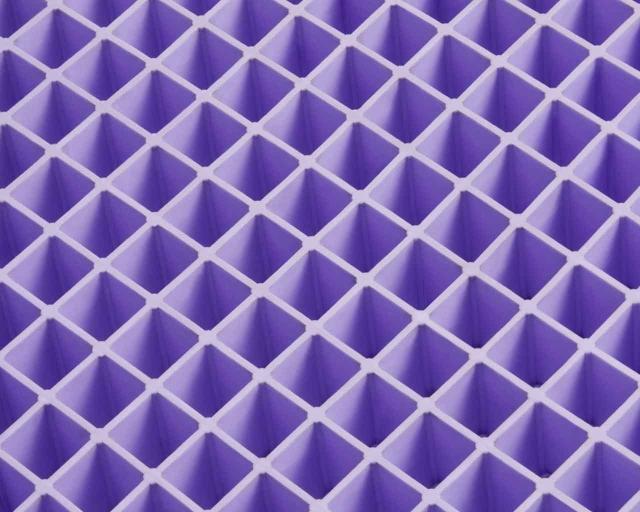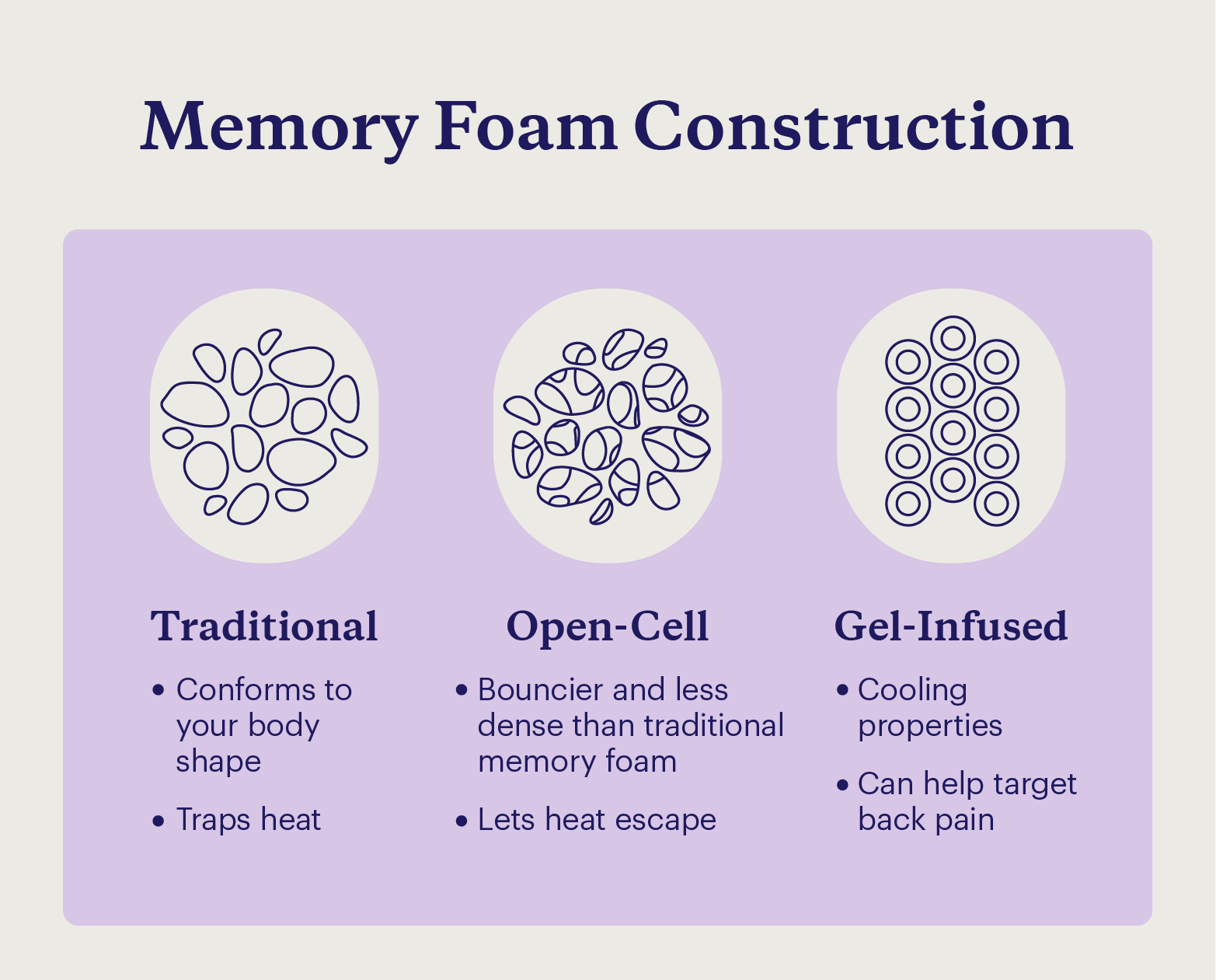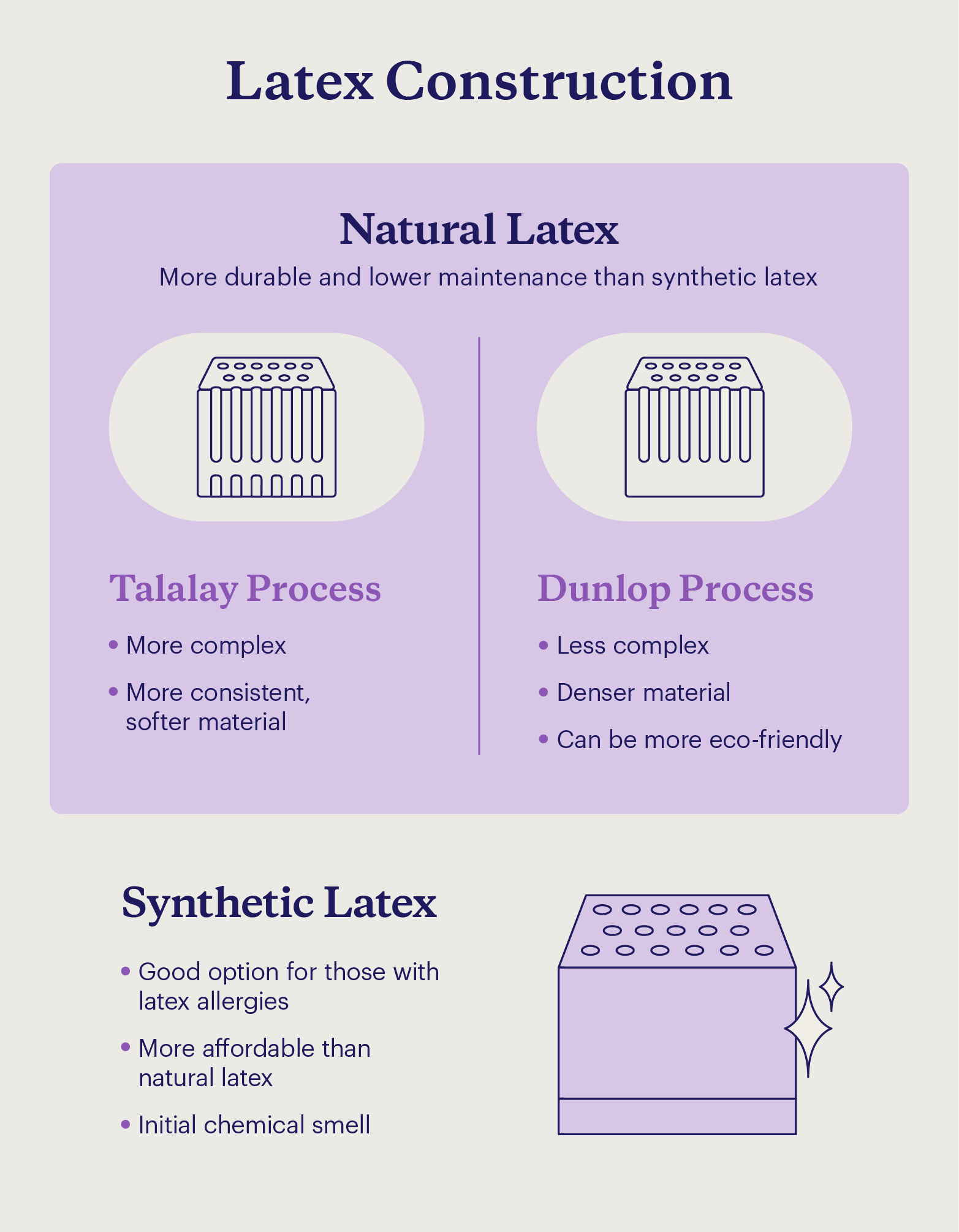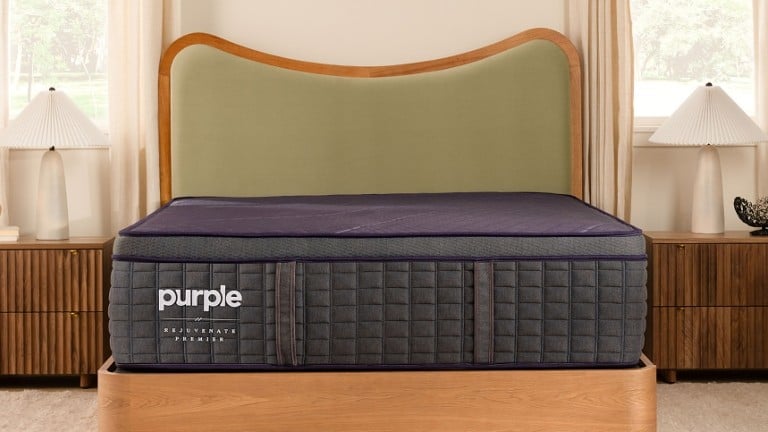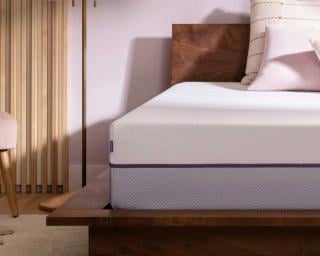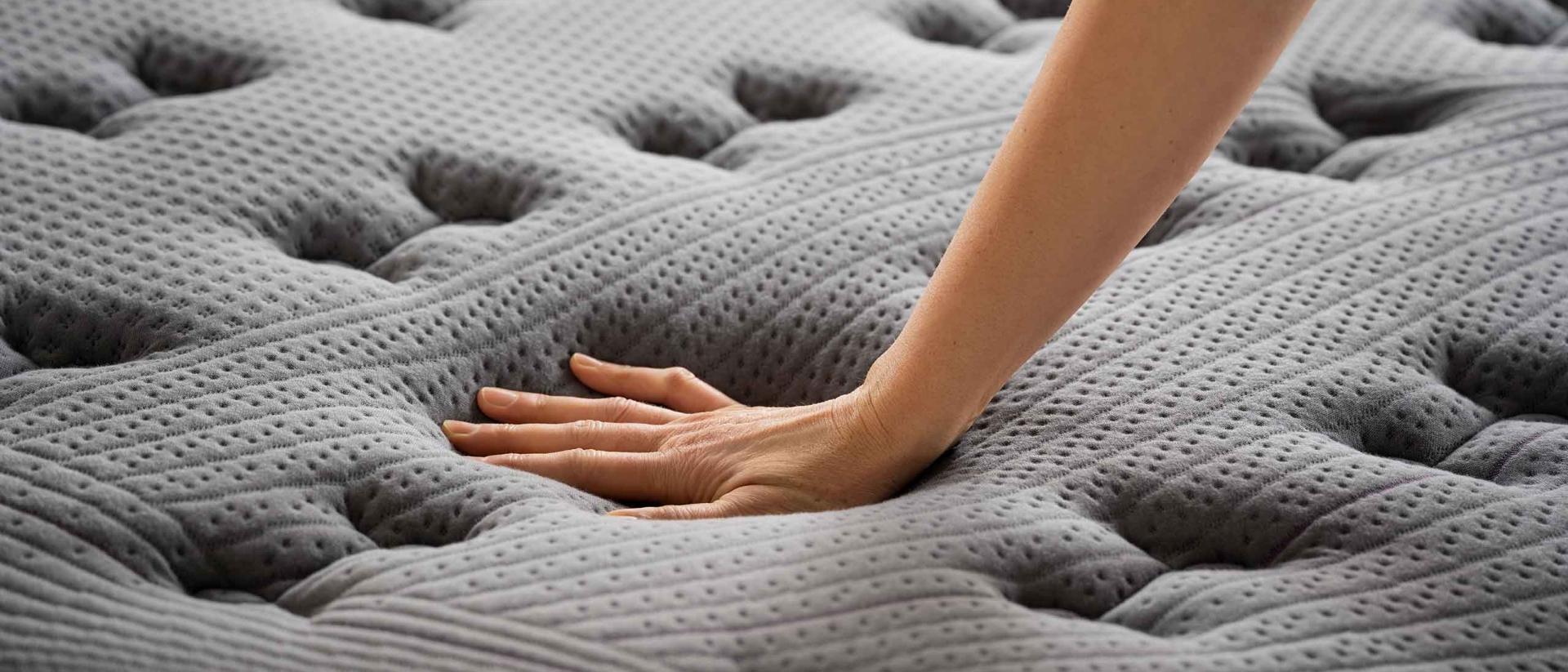
Latex vs. Memory Foam: Understanding the Difference
Key takeaways for latex vs. memory foam:
- Latex is quick to adapt, while memory foam has a slower responsiveness.
- Latex offers more of a lifted feel, while memory foam has more of a sinking sensation.
- Latex is more breathable and cool, while memory foam retains heat.
Latex and memory foam are common materials used in mattresses and pillows. While both are most known for their support, they have some key differences that make an impact on your sleep.
Keep in mind that these differences will depend on the quality of both materials and may also vary between brands. This guide will help you get a better understanding of each material's feel and functions so you can decide if a latex or memory foam mattress or pillow is right for you.
Purple’s proprietary GelFlex Grid® combines the popular benefits of both — such as latex’s instant adaptivity and breathability, plus memory foam’s superior support and reduced motion transfer — while leaving behind the negatives such as latex’s non-hypoallergenic makeup and memory foam’s heat retention.
What Is Memory Foam?
Memory foam is made with polyurethane foam and other chemicals to create viscoelastic foam. This material slowly molds to the shape of your body and gradually regains its original form after weight is removed.
The benefits of a memory foam mattress include cloud-like comfort and even distribution of body weight for exceptional support. Its lack of resilience also allows for superior motion isolation.
Memory foam may not be best for active sleepers — since the material doesn’t respond to movement quickly, moving through the night can be difficult. Additionally, memory foam may be bad for your back if you have the wrong firmness level.
Traditional memory foam in pillows and mattresses also absorbs and traps body heat. This can be good for cold sleepers but may be uncomfortable for warmer sleepers or those who live in warmer climates.
Pros | Cons |
| Disperses weight equally for superior support | Retains heat depending on type |
| Often preferred by back and side sleepers | Not as durable or supportive as latex, depending on the quality |
| More hypoallergenic than latex | May be uncomfortable for stomach sleepers |
| Less motion transfer |
In addition to traditional memory foam, there are other types of memory foam.
- Traditional memory foam: This material is made of polyurethane by-product and has closed cells that trap heat.
- Open-cell memory foam: Alternatively, this type of memory foam is designed with openings to let heat escape a little more than traditional memory foam. It’s also a bit bouncier than traditional memory foam.
- Gel memory foam: This type provides slight cooling effects, but it can be pricier than other memory foam types.
Foam Mattress Examples
Not all foam mattresses are designed the same — some are made of memory foam and others are made of other types of foam materials. For example, here are some of Purple’s mattresses that incorporate foam layers for additional benefits and comfort.
- PurpleFlex® Mattress: The SoftFlex Cover in this mattress optimizes the already adaptive and breathable GelFlex Grid®. Stable Base Foam layers and Edge Support Foam provide extra support for a comfortable night’s sleep.
- Purple Mattress®: This mattress includes a 2-inch GelFlex Grid® layer that instantly adapts as you move and balances temperatures. It’s paired with Comfort Foam, Edge Support Foam, and a Durable Base Foam for added pressure relief, support, and durability.
- Purple Plus® Mattress: Made with the GelFlex Grid® and Ultra Comfort Foam, this mattress isolates movement and enhances cradling comfort and breathability. Dual layers of Base Foam help boost stability and support. It also includes Edge Support Foam to increase durability and make it easier to get in and out of bed.
What Is Latex?
Latex is crafted from a natural or synthetic rubber material, which is known for its springy and responsive nature. The material contours to your body, offering support and pressure point relief for a comfortable sleep experience.
Latex mattresses also offer motion isolation, which can be helpful for individuals who move frequently during the night and want to minimize disruptions to sleeping partners. Additionally, the material is highly breathable and cooling due to tiny pinholes in the foam layers that enhance airflow and prevent body heat retention.
Latex mattresses require less flipping or rotating compared to other mattress types. It’s a durable option, but that also means it’s a notably heavier mattress.
Pros | Cons |
| Breathable | Not as hypoallergenic as memory foam due to latex allergies |
| Durable | More expensive than memory foam |
| Good for active sleepers | Heavier than other mattresses |
| Natural latex can be more eco-friendly |
Different types of latex may create some differences.
- Organic or natural latex: These types are derived from rubber tree sap through the Talalay or Dunlop process. The Talalay process is more complex and produces a more consistent, softer latex. In comparison, the Dunlop process is simpler and creates a denser latex.
- Synthetic latex: While less expensive than organic or natural latex, synthetic latex mattresses require more maintenance, are less durable, and have an initial chemical smell.
Latex Mattress Alternatives
Some sleepers seek out latex mattresses for their cool, responsive surface, but those with latex allergies or people who don’t like the bouncy feel may seek alternatives that offer similar benefits.
With innovative DreamLayer™ Technology and GelFlex Grid®, Rejuvenate® Luxe Mattresses are some of the best alternatives to traditional latex mattresses. Temperature-balancing comfort, soothing pressure relief, and unparalleled support combine in our most luxurious mattress collection.
Differences Between Latex and Memory Foam
While the differences between latex and memory foam are often dependent on the quality, here are some general differences between the two materials.
Latex | Memory Foam | |
Feel | Buoyant and responsive | Conforming with a sink-in sensation |
Support | Natural lifting feeling | Disperses weight to support the entire body |
Pressure Relief | Responsiveness allows it to relieve pressure points in changing sleep positions | Molds to curves and weight to reduce pressure |
Breathability | ✓ | X |
Motion Transfer | Dampens motion | Minimal motion transfer |
Responsiveness | Bounces back to its original shape rapidly | Takes a moment to regain its shape |
Construction | Rubber tree sap or synthetic materials | Polyurethane foam and other chemicals |
Durability | Mattresses: 10 to 15 years Pillows: 3 to 4 years | Mattresses: 7 to 10 years Pillows: 18 months to 3 years |
Allergies | Hypoallergenic (not for those with a latex allergy) | Hypoallergenic |
Mattress Weight | Heavy | Light to medium |
Sustainability | Natural latex can be eco-friendly | May have eco-friendly options but is oil-based |
Availability | Less common in some regions | Widely available |
Price | $$$-$$$$ | $-$$$ |
1. Feel
Memory foam mattresses offer a contour-hugging, sink-in experience. The material molds and softens to the body’s shape and weight, which cradles pressure points and offers a cocoon-like comfort. The slow responsiveness allows it to adapt gradually, creating a more enveloping feel.
While latex mattresses are available in different firmness levels, they are generally known to be more firm. They’re also more responsive, providing a supportive and slightly bouncy sensation.
2. Support
Memory foam and latex mattresses both offer excellent support, but the difference lies in how they deliver it with the suitability depends on individual preferences. Memory foam mattresses excel in molding to the body’s shape to offer a more personalized support system and sink-in feeling.
Alternatively, the natural resilience of latex gives it a more buoyant feel, making it ideal for those who prefer more lift. Its responsiveness also allows it to quickly adapt to your body weight for a consistent level of support. It still conforms to your contours, but it rises to fit your body as you move throughout the night.
Mattress weight limits can play a role. For instance, the density of latex mattresses may be a better option to support heavier body types.
3. Pressure Relief
Memory foam mattresses contour to the body’s shape and cradle pressure points. Since it takes a long time for memory foam to revert to its original shape, it customizes to your body over time for a pressure-relieving sleep experience.
Latex mattresses offer pressure relief by adapting to your body’s movements quickly, preventing concentrated stress on specific areas as you shift throughout the night. The lifted feeling from the supportive latex also minimizes strain on pressure points.
4. Breathability
Memory foam mattresses are far less breathable than latex mattresses, unless you opt for an open-cell or gel-infused memory foam. This is because memory foam absorbs and retains body heat, while latex’s natural open-cell structure facilitates airflow for a cooler sleep environment.
5. Motion Transfer
Both memory foam and latex mattresses minimize disruptions caused by movement. Memory foam mattresses may be slightly more effective in reducing motion transfer due to their slow rebound properties. However, the extent of motion isolation can also depend on the specific construction and quality of the mattress.
6. Responsiveness
How the material responds to the body is one of the key differences between memory foam and latex. While memory foam contours gradually to the body’s shape, latex offers a faster rebound that promptly adapts to changes in sleep position.
The choice comes down to personal preference for the level of bounce and how quickly you want the mattress to respond to changes.
7. Construction
Memory foam is made from polyurethane foam mixed with other chemicals to create viscoelastic foam. Latex mattresses use natural latex, made from rubber tree sap using the Talalay or Dunlop process, or synthetic latex made with petroleum-based materials.
8. Durability
How long your mattress lasts largely depends on the quality of materials and the manufacturer. Latex mattresses are generally considered highly durable and can last up to 15 years, while memory foam mattresses last seven to 10 years on average.
Although mattresses can last up to 15 years, it’s a good idea to replace them earlier. Over time, mattresses retain contaminants and become heavier with collected dead skin cells.
9. Allergies
Latex mattresses, specifically those made with natural latex, may pose a risk for individuals with latex allergies. While synthetic latex can minimize allergens, latex-sensitive individuals should exercise caution.
Memory foam mattresses are generally hypoallergenic and less likely to trigger allergies. However, some people may be sensitive to the chemicals used in memory foam production, so individuals with known sensitivities should carefully assess both options.
10. Mattress Weight
The weight of memory foam mattresses varies, but they’re typically lighter than latex mattresses. Latex is naturally more dense, so these mattresses are notably heavier. Keep this in mind if ease of maneuverability or transportation is a concern.
Weight ranges will vary from brand to brand, but here’s how much you can generally expect your mattress to weigh:
- Memory foam: 75-90 pounds
- Latex: 140+ pounds
11. Sustainability
Natural latex mattresses specifically made with the Dunlop process are the most sustainable option, as they’re made from rubber tree sap with a more simple, eco-friendly manufacturing process. The Talalay process has a more complex production, and memory foam is made with chemicals.
Synthetic latex and memory foam can be made more sustainably depending on the brand, and they can also be recycled or repurposed in some pillow types and other items.
12. Availability
Memory foam mattresses are widely available and dominate the market, with numerous brands offering a diverse range of options and price points. Latex mattresses, while still accessible, may be less prevalent in some regions, and the variety of choices may be comparatively limited.
13. Price
How much you spend on a mattress will ultimately depend on the quality you choose for either material. Latex mattresses tend to be pricier, particularly those made from natural latex due to the cost of harvesting and processing the materials. Memory foam mattresses have a wider range of price points, influenced by the density and quality of the material.
Latex vs. Memory Foam Pillows
Latex and memory foam pillows also contain their own set of distinct benefits, and depending on your needs, you may find significant differences in pillow costs, feels, and features.
The Purple Harmony™ Pillow is a Purple’s bestselling pillow made with a Talalay latex core that creates a bouncy, cooling feel, while the honeycomb-patterned GelFlex Grid® contours to your facial features, head, and neck to provide support and pressure relief.
Latex pillows:
- Are supportive and resilient with a buoyant feel
- Offer effective pressure relief and maintain a consistent loft
- Are naturally hypoallergenic, but those with latex allergies should avoid
- Excellent durability
- Come in mid to high price ranges, with natural latex pillows being more expensive than synthetic
Similar to memory foam, the Purple DreamLayer™ Pillow provides conforming pressure relief and contour-hugging support. Removable layers paired with our proprietary GelFlex Grid® create the melt-in comfort of traditional memory foam minus the heat and delayed response.
Memory foam pillows:
- Are conforming and plush, molding to the contours of your head and neck
- Offer excellent pressure relief, particularly for specific pain points
- Are hypoallergenic
- Are fairly durable but have a shorter lifespan than latex pillows
- Come in a wide range of price points
Consider Alternatives With Purple
If you’re stuck between a latex and. memory foam mattress, there are alternatives like hybrid mattresses. This type of mattress is made of multiple layers, including a foam or latex layer and coils for the best of both worlds. Benefits include:
- Durability
- Pressure relief
- Breathability
- Motion isolation
- Wide range of material options
You also might consider memory foam vs. Purple’s GelFlex Grid® material for both mattresses and comfortable pillows. The GelFlex Grid® offers:
- Temperature regulation
- Multiple firmness levels
- Hypoallergenic material
- Conforming support
- Durability (plus a 10-year warranty)
Overall, the choice of materials for pillows and mattresses is highly personal. But if you find yourself between a latex and memory foam model, consider an alternative like a hybrid or GelFlex Grid® mattress.
FAQ
Whether you buy a latex or a foam mattress is ultimately up to your personal preference. Each type of mattress has its pros and cons. One of the benefits of memory foam is that it provides excellent motion isolation and pressure relief. However, it’s less breathable and durable than latex.
Latex is a responsive material that can provide consistent support as you move throughout the night. On the other hand, it can be a very heavy material and isn’t suitable for those with latex allergies.
Latex mattresses generally last longer than memory foam mattresses; however, it depends on the quality and manufacturer of both materials.
No, the Purple Mattress® doesn’t use latex. Instead, Purple’s mattresses feature the innovative hyperpolymer GelFlex Grid®, which provides superior pressure relief and temperature-balancing benefits.
No, memory foam isn’t latex. Memory foam is made from polyurethane and other chemicals, while natural latex is harvested from rubber trees and synthetic latex is made from petroleum-based materials.
More to Explore
Level-up your sleep routine with our most-loved products.

